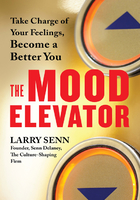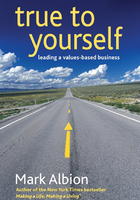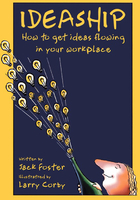Change your thoughts and you change your world.
—NORMAN VINCENT PEALE
Once we understand that our thinking creates our moods, we still face a problem: we can generally justify our thinking no matter how unreasonable it may be. Recall how John in chapter 1 came up with seemingly logical evidence to support his feelings about his job at Tip-Top Products, even as those feelings veered wildly from positive to negative and back again. The fact is that our thinking does not serve as a very trustworthy guide to how we are doing in life. If you simply listen to your thinking, you'll likely remain stuck on whatever floor on the Mood Elevator your thoughts delivered you to in the first place.
But there is good news. Fortunately, we human beings are endowed with not only the gift of thought but also the gift of emotion. Each thought provokes a feeling, and every feeling we experience is a signal about how we are relating to the world. In a sense, the Mood Elevator is just a “feelings barometer”—a sensitive instrument that reflects the varying state of our emotions from high to low. So when you want to know how you are doing, look to your feelings as your guide. They can provide meaningful clues to the reliability of your thinking and the impact it is having, not only on you but on those around you, as well.
Learning to Read Your Human Dashboard
The big news in autos today is electronics. The dashboards in new cars feature an amazing array of information, from engine warning signals to tire pressure. The Mood Elevator is your human dashboard. The moods you experience can let you know how things are working inside you, at levels of emotion you may find difficult to understand or analyze.
Just as a red light on your car's dashboard starts blinking when the engine is overheating, rising anger offers a warning when your emotions start heating up. And just as your car's gas gauge warns you when you are low on fuel, the feelings of apathy and depression let you know when your emotional energy level is at a low ebb. And just as your GPS navigation system announces “Recalculating!” when you make a wrong turn, feelings like frustration and anxiety can alert you when you are on the wrong path and need to reevaluate your direction.
That's one important purpose of the Mood Elevator: it acts like a human dashboard to let you know how you are doing. If you can learn to notice your feelings as they change—particularly when you find yourself slipping toward the lower floors—you can allow those warnings to trigger corrective actions, following the pointers in this book. This will help you spend more time living up the Mood Elevator—and at your best.
Over time you'll become sensitively attuned to the blinking lights and warning signs that alert you when you are drifting down to the lower levels—especially when the floor is a familiar one that you've visited many times.
My most common lower floor is impatience. I experience it in a variety of ways, some of which may be familiar to you as well:
Why is this darned traffic moving so poorly?
Of course, the checkout line I chose turns out to be the slowest—and now the customer in front of me is arguing about a 50-cent coupon!
Why is it taking so long for my computer to boot up?
Come on, people—we've talked about this business issue for 30 minutes. Let's just make a decision!
I've learned to recognize the emotions that accompany impatience. I feel tense, a little irritated, even a bit “bottled up.” If the feeling lasts for more than a few minutes, it can easily morph into anger. And it often leads to foolish choices: I make an irritable remark to the cashier, who is doing her best to handle the line of customers, or I rush to conclude a business discussion before all the facts have been fully evaluated.
Worry is another familiar lower floor to me. It comes with its own set of feelings—usually not as intense as anger but sometimes even more unsettling. I most often recognize worry by noticing that the stories I am creating in my thoughts are going around and around in circles—and with each revolution the imaginary outcome gets worse and worse. If I don't take steps to stop the worry cycle, a small source of concern can become a major drama.
One recurring cycle for me has to do with my passion for physical fitness. I'm driven to keep in shape because of my deep-seated belief that fitness improves mood and mental well-being. For me there is nothing like a morning jog to clear my mind and start the day up the Mood Elevator. It is also when I get my most creative original thoughts and solve problems. I've been blessed to be able to jog decades longer than most people, whose knees go by their sixties. For many years now, every time I feel even minor knee pain while running, I have to be on guard or my thinking can weave a disaster scenario: Maybe my knees are finally going. Then I can't run anymore and I won't be as creative. I won't be able to stay in shape by training for triathlons. Without cardio exercise, my longevity could be affected.
Awareness is the key to reading your human dashboard. Carrying a Mood Elevator pocket card as a handy reminder helps keep that awareness front of mind. Learning to read the signals your feelings evoke is important because the first step in managing mood states is knowing which one you are in.
You can download and print your own Mood Elevator pocket card by visiting this link: bkconnection.com/moodelevatorpocketcard
Lulled into Unconsciousness: The Problem of Unhealthy Normal
Unfortunately, there is a phenomenon that makes it more difficult to recognize and manage our mood states. I call it unhealthy normal. It occurs when any lower-floor mood state and its related feelings become so familiar that we don't notice them anymore. The negative state becomes our “new normal,” escaping our conscious awareness and therefore becoming very difficult to alter.
The old story of the boiled frog offers a handy example of how unhealthy normal can happen. As the story goes, if you put a frog in a pan of water and increase the heat very slowly, the frog won't notice the temperature change; therefore it never leaps out of the pan—and it ends up a boiled frog.
I understand that some biologists believe the boiled-frog phenomenon is not actually scientifically accurate; in fact, they tell us that a healthy frog will recognize the change in water temperature and jump to safety. But the metaphor is nevertheless useful because, ironically, it captures a familiar aspect of human psychology.
People often adjust to unhealthy environmental conditions in a way that resembles the frog. For example, for a few weeks after Senn Delaney moved its headquarters into a new office building adjacent to the I-405 freeway in Huntington Beach, California, I was bothered by the constant sound of traffic. Today when guests ask how I manage to work with the noise, my response is, “What noise?”
I've adjusted in a similar way to the often hazy skies in the Los Angeles area. Our oldest son, Kevin, is a famous kiteboarder known as Top Hat; he owns Hawaii Surf and Sail, an apparel store in Haleiwa, Hawaii, on the legendary north shore of Oahu. We love to visit Kevin and his wife whenever we can. The constant trade winds in the islands ensure that the sky is a magnificent shade of blue, with air that is extremely pure. Later, when we fly back into Los Angeles, I am always shocked to see the haze in which I've grown accustomed to living. Within a few days, of course, I'm no longer aware of it.
Unfortunately, we all run the risk of becoming boiled frogs when it comes to habitual emotional states. Think about a time when you found yourself routinely bothered or irritated by people and events—perhaps when you were working in an organization suffering from some dysfunctional behavior patterns. Hopefully, you remedied the problem by changing either your circumstances or the thoughts you embraced in response to those circumstances. But if you didn't, you may have found yourself gradually becoming more and more bothered until the state of irritation was so familiar you no longer even noticed it.
Eventually, a mood of impatience, frustration, and pessimism became your unhealthy normal. You may have gone through life unaware of your habitual unhappiness until something external brought it to your attention—perhaps an encounter with an old friend who remarked, “Wow, what's eating you? You never used to walk around with a scowl like that on your face!”
There are many manifestations of unhealthy normal. At one point in my life, my unhealthy normal was excessive intensity. I was overly concerned about getting everything done, doing everything right, meeting every deadline, never disappointing anyone, and being successful at everything I did. I was continuously wound up. Except for those relatively rare times when I took a real break—such as a long vacation—I didn't even remember that it was possible to experience a calmer, more peaceful existence.
For others, habitual states of insecurity, judgment, worry, blaming, anger, or depression may become their unhealthy normal. The problem, of course, is that if you don't notice your state of unhealthy normal, you won't be prompted to do anything about it. A habitual mood can become a self-destructive way of life.
Thankfully, there is something you can do. The key is to make a continuous, conscious effort to pay attention to your feelings by reading your own dashboard and reacting appropriately.
Sometimes recognizing a state of unhealthy normal requires being sensitive to external cues—like a driver who doesn't realize he has a burned-out headlight until another driver alerts him to the trouble.
In my case it was promptings from family, colleagues, and friends that made me realize that excessive intensity had become my unhealthy normal. I set to work to recognize when my overly driven nature was giving rise to feelings of impatience, anxiety, and irritation. In time my sensitivity increased until those emotions became like a loud bell that I found impossible to ignore. I developed the habit of taking a deep breath and saying to myself, There you go again! It's time to escape from that mood of excessive intensity. Be calm. Be present. And take life just a little easier. Over time my periods of excessive intensity greatly diminished.
We are all gifted with a personal dashboard that can save us from the worst mood disorders—but it won't do you any good unless you read it. Pay attention to the signals you get, internally and externally, and learn to be a sensitive monitor of the emotional gauges on your human dashboard.
Unhealthy Normal and Relationships
When my wife's parents used to come visit us, she and I would notice how much they bickered. They would disagree about the most inconsequential things and constantly make each other wrong through subtle put-downs or sarcastic shots. They were oblivious to their continuous state of hostility; it had become their unhealthy normal, and they didn't notice it or see anything wrong with their relationship.
My in-laws aren't alone in this pattern of behavior; destructive, unhealthy-normal mood states often arise in long-term relationships. Couples start to take each other for granted, stop communicating appreciation for each other, and gradually lose touch with their feelings of love and affection.
There's no sphere of life in which paying attention to your feelings is more important than in close relationships. The feelings to watch for and cultivate are love, appreciation, forgiveness, nonjudgment, and compassion. When you keep these feelings alive, relationships flourish. When you stop monitoring your emotions, an unhealthy normal may develop, in which judgment, faultfinding, resentment, grudge holding, and bitterness take root.
George Pransky and his wife, Linda, head a counseling practice for individuals and organizations based in the state of Washington. They often work with couples to help them understand the three principles of mind, thought, and consciousness that they consider central to healthy relationships. Sydney Banks, who helped formulate the three principles, defines them as “Mind, which is the source of all intelligence, Consciousness, which allows us to be aware of our existence, and Thought, which guides us through the world we live in as free-thinking agents.” Pransky teaches the concept that “consciousness makes thought appear real to each person in the moment, and therefore individual reality is created via the medium of personal mindsets and thinking.”[5] You might notice that this is a philosophical version of the ideas presented in this book.
George Pransky tells the story of a couple who came for a four-day residential retreat because they felt that love was leaving their marriage. He helped them see that habitual practices of arguing, fighting, and making each other wrong had become their unhealthy normal.
Uplifted by this new insight, the couple left the retreat in a loving and hopeful state, but a week later George got a panicked call from the husband. “We've failed,” he announced. “We just had a fight, and we are both so upset that we did.”
George replied, “Congratulations! You noticed this time, and you didn't like it. That's the best thing that could have happened.” The couple's undesirable behaviors and accompanying feelings had become a loud bell that they couldn't help but notice—the first and most important step toward positive, lasting change.
Unhealthy Normal in Organizations
In Senn Delaney's work with corporate clients, our goal is to inspire, educate, and partner with them to foster healthy, high-performing organizational cultures. When we run a set of cultural diagnostics, we almost always discover some behaviors and attitudes that are hindering them from achieving the positive, creative, productive state to which they aspire. It takes an outsider to see these dysfunctions clearly because people who have been together for a while develop what could be called familiarity blindness—an organizational form of unhealthy normal.
Sometimes unhealthy-normal habits develop in an organization as a result of deliberate choices by the company's leaders.
One of the most extreme examples is the story of Enron, the energy and commodities trading firm based in Houston, Texas, that back in the 1990s was widely admired as one of the world's most creative, unconventional—and seemingly profitable—companies. Fortune named Enron “America's most innovative company” an unparalleled six years in a row.
In the midst of this remarkable run of success, I was asked to meet with Enron's top executives, who were interested in exploring ways that Senn Delaney could help them foster an even more successful culture. Our team quickly realized that Enron's culture was driven entirely by an excessive focus on self-interest. We pointed this out and warned the company's leaders that, in the long run, this approach to business carried significant dangers and was ultimately unsustainable. But they told us they wanted even more of what they already had—a culture centered on extremely high performance expectations permeated with an every-person-for-themselves, dog-eat-dog, results-at-any-cost mind-set.
We turned down the engagement. A few years later, in late 2001, the company collapsed, embroiled in one of the most gigantic cases of corporate fraud in history. Subsequent accounts revealed that Enron had pushed—and exceeded—the limits of integrity and ethics in search of ways to maintain its string of increased quarterly earnings. The few people within Enron who understood what was happening and tried to call it out became social outcasts, thanks to the unhealthy-normal behavior pervasive throughout the organization.
Granted, Enron is an extreme example, but a lack of collaboration coupled with excessive self-interest is perhaps the most common dysfunctional organizational habit. Senn Delaney saw that early on in our work to help transform the culture of the regional Bell telephone companies after the giant AT&T divestiture in 1982.
Bell Atlantic, composed of state phone companies on the Eastern Seaboard, was our first telecom client. Its CEO, Ray Smith, knew he needed to quickly convert a monopolistic, state-centric company into a collaborative global competitor, and he called on Senn Delaney to help.
We recognized that we had a challenge on our hands when Bell Atlantic employees told us that it was common for workers in one state phone company division to celebrate if another state phone company lost a rate case with the local regulators, even though this hurt the company's profits. “When they lose, it makes us look better by comparison!” they explained. A friendly rivalry among members of the same organization may help encourage hard work and creativity, but when it causes people to rejoice at the misfortunates of colleagues and partners, it's a sign that the culture has gone badly awry.
Another dysfunctional organizational habit that is all too common is the blame game. We are taught from child-hood—thanks in part to sports and games—that for me to win, you have to lose. That dynamic shows up in organizations as well as in families and couples, where it takes the form of one person needing to be right while making the other wrong. When that becomes an unconscious habit, organizations suffer and marriages can end.
Early in our work developing Senn Delaney's culture-shaping model, our retail consulting group was doing some projects for the JL Hudson department stores in Detroit, then part of the Dayton Hudson retail giant and now part of Macy's. One assignment was to improve the dismal performance of the company's Warren Distribution Center, where goods were received from vendors, checked, marked, sorted, and then sent off to the stores.
After a thorough study of the center's operations, we couldn't find anything wrong with its layout, equipment, systems, or processes, but our interviews revealed an almost terminal case of lack of accountability. Everyone said there was a problem—but then pointed to someone else as the cause of it. The markers blamed the checkers, the checkers blamed the buyers, the buyers blamed the vendors, and the venders blamed the markers.
In a leadership session with the distribution team, we surfaced their blame-game mentality and replaced it with a mind-set of accountability. This paved the way for across-the-board improvement in business practices over time. Eventually, the Warren Distribution Center was transformed from the worst to the best performer in the Dayton Hudson group.
Heeding the Warning Signs
How can you recognize when dysfunctional attitudes and behaviors have become your unhealthy normal? Check your Mood Elevator and use your feelings as your guide—so long as those feelings haven't themselves become an unhealthy normal. If that's the case, you need to relearn to recognize your lower-floor emotions. Start by seeing whether you can identify any unhealthy-normal tendencies you might have:
Images Impatience
Images Pessimism
Images Irritation
Images Anger
Images Anxiety
Images Worry
Images Excessive intensity
Images A judgmental attitude
Images Insecurity
Images A sense of unworthiness
Images Neediness
Images The need to be right
Images Argumentativeness
Images Self-righteousness
Images Disconnection
Images Blaming or excuses
Images An unwillingness to admit mistakes
Pay attention to these feelings when you experience them; listen carefully for external cues that can alert you to their presence. If friends, associates, or family members start dropping hints that they have detected in you the attitudes or behaviors associated with these emotions, don't dismiss them. Take them seriously; they are trying to tell you that your human dashboard is flashing warning lights—signs that you have been overlooking.
Once you start to recognize the unhealthy patterns of behavior in your life, learning to catch—and respond to—the feelings associated with those patterns can be extremely useful. We explore ways to do that in later chapters.
第7章 Braking Your Mood Elevator: The Power of Curiosity
The highest form of human intelligence is to observe yourself without judgment.
—JIDDU KRISHNAMURTI
Throughout this book we've been using the metaphor of the Mood Elevator to describe how our emotions rise and fall. But of course there are countless real elevators in use around the world every day. Experts say that passengers take more than 18 billion elevator trips annually in the United States alone. Why is it that you never hear about elevators plummeting to the basement? That only happens in horror movies and nightmares because, in addition to being safely built and inspected, all modern elevators have a series of automatic brakes that prevent them from falling, even if a cable snaps. Thanks to this ingenious system (invented by Elisha Otis back in 1852), riding in an elevator is actually far safer than taking the stairs.
In a similar way, you can learn to activate a brake on your Mood Elevator. There's an automatic system designed by nature to catch you before your emotional state falls too far and too quickly—provided you choose to employ it.
Look back at the Mood Elevator map in chapter 1. Where would you draw a line between the higher states and the lower states?
The dividing line is “curious, interested.” It appears right in the middle of the map, and it serves as an ideal braking point before you drop to the lower mood states. Living life with more curiosity is a great way to avoid dropping to the lower floors. Here's how it works.
When something happens that threatens to make you plunge to the bottom on the Mood Elevator—for example, when someone says or does something you disagree with or fail to understand—you can choose to be irritated, distressed, or judgmental. You can respond by thinking, What a stupid thing to do! That just ruined my whole day! They must be trying to get my goat! You'll immediately feel your emotions pulling your Mood Elevator to the basement.
On the other hand, you can choose to be curious. You can respond by thinking, I wonder why they did that. What an unusual and surprising thing to do. It would be interesting to understand what caused them to act that way.
When life throws you a curve, you can become angry, depressed, or defensive—or you can put your energy into learning from the situation and developing creative ways to comprehend and respond to it. This requires a curious mind. The ultimate outcome will vary, but you will always be further ahead if you begin with curiosity.
Resisting Your Emotional Impulses
To understand why curiosity can serve as a brake on your Mood Elevator, look at the following paragraph. What kinds of thoughts and emotions does it trigger in you?
Those taht raed tihs hvae a sgtrane mnid. Olny 55 plepoe out of 100 can. I cdnuolt blveiee that I cluod aulaclty uesdnatnrd what I was rdanieg. The phaonmneal pweor of the hmuan mind. Aoccdrnig to rscheearch at Cmabrigde Uinervtisy, it dseno't mtaetr in what oerdr the ltteres in a word are, the olny iproamtnt tihng is that the frsit and last ltteer be in the rghit pclae. The rset can be a taotl mses and you can still raed it whotuit a pboerlm. This is bcuseae the huamn mnid deos not raed ervey lteter idnidivaluly but the wrod as a wlohe.
It is certainly an odd-looking paragraph. Did you try to read it? If so, were you able to make sense of it? If the readers of this book are typical, only about half of you will be able to read the paragraph.
More important, what kinds of thoughts and emotions did you experience? Did you find the paragraph's jumbled letters confusing and irritating? Did you quickly give up on trying to read it? Did you find yourself thinking, What a stupid exercise! How am I supposed to figure out this nonsense? or This is a big waste of time.
If you responded like that, you are like many people. Lots of us tend to react to events that are confusing and upsetting by quickly dropping to one of the most popular floors on the Mood Elevator—the one near the bottom: judgmental/blaming.
Now go back to that odd paragraph and try reading it again. You may find it helpful to start with the last sentence first. Take the paragraph slowly, one sentence at a time. Little by little the words and ideas may gradually fall into place.
If that doesn't work, take a look at the same paragraph with the words spelled correctly:
Those that read this have a strange mind. Only 55 people out of 100 can. I could not believe I could actually understand what I was reading. The phenomenal power of the human mind. According to research at Cambridge University, it doesn't matter in what order the letters in a word are, the only important thing is that the first and last letter be in the right place. The rest can be a total mess and you can still read it without a problem. This is because the human mind does not read every letter individually but the word as a whole.
This example is based on a scientific study investigating how the mind works. Our ability to correctly interpret oddly spelled words is an interesting psychological curiosity that may not seem important in itself—but the way you reacted to the exercise has significant implications.
If you reacted with annoyance and irritation, you've vividly experienced how our Mood Elevators often work. When unusual or surprising events happen, thwarting our expectations and posing difficulties we're unprepared for, we tend to experience uncontrolled emotional responses that quickly carry us to the lower levels.
On the other hand, you may have responded with curiosity. This could have taken several forms, such as a strong desire to unravel the meaning of the paragraph, wondering about the purpose of the unexpected exercise, or perhaps a sense of humorous puzzlement as you gradually untangled a word here, a word there, and slowly discerned the ideas behind entire sentences.
If this was your reaction, congratulations! You see how curiosity can help save you from falling to the bottom levels of your Mood Elevator—while also providing you with an attitude that is tremendously valuable for disentangling many of the knotty challenges that life throws our way.
Here Comes the Judge
Many people tend to respond to experiences that are new and different by swiftly traveling to the Mood Elevator floor labeled judgmental/blaming.
It's important to distinguish “being judgmental” from the simple, necessary act of judgment. Of course, we all make judgments every day—about how we will behave, what we will or will not do, tasks or projects we will undertake, how we will tackle problems, and so on. But being judgmental is another matter; it's about rushing to judgment by quickly condemning things, ideas, or people that are unfamiliar or challenging, without taking the time to learn about them or even think about them.
There are a number of reasons why being judgmental can be tempting.
Being judgmental relieves us of the hard work of trying to understand something that is unfamiliar. It lets us quickly categorize it according to a simplistic, superficial standard, which is much faster and easier—although the results are often incorrect and ultimately unhelpful.
Being judgmental gives us the pleasurable sensation of being “right” and labeling others as “wrong”—although it often leads to misunderstandings and conflicts that end up causing us more pain than pleasure.
Being judgmental allows us to retain beliefs, concepts, and images of the world that are familiar and comfort-able—although it also limits our ability to expand our minds, experience new things, and grow in wisdom and understanding.
Our tendency to judge is why we get into heated arguments with people—including colleagues, friends, and loved ones—about things that really don't matter. It is why so many people are prone to see what is wrong with anything that is new or different rather than what is right about it—or what can be learned from it. Our tendency to rush to judgment rather than exercise our natural sense of curiosity is the cause of many strained relationships. It's a major reason why most organizations are not as agile or creative as they could be.
Practically everyone is capable of falling into the trap of being judgmental in certain situations. Consider these hypothetical ones:
Images Your boss announces that the company has chosen a new software system to manage all of your operations at work—and learning how to use it will require two days of training and studying a 100-page manual.
Images Over dinner your spouse presents you with plans to travel to a new vacation spot that is completely different from the one you love best.
Images A new colleague at work has a background that is very different from yours; perhaps she's from another country and has a unique education and career path. You're told, “Meet your new partner!”
Images A family member—a child, a sibling, a parent—informs the family that he or she is making a dramatic life change: a new career, a marriage, a move to a distant state.
Images Your company announces a merger with a rival firm whose methods, values, and culture are quite different—and you are one of the employees chosen to move to the new operation.
Can you imagine how you might respond, intellectually and emotionally, to one of these situations? You may even have felt yourself reacting with anxiety, irritation, and fear simply from reading these brief descriptions. If so, you can understand why people tend to respond to new challenges with a judgmental attitude, rather than suspend judgment in favor of a spirit of curiosity, openness, and discovery.
Even the most inventive, creative people can fall prey to the tendency to make snap judgments rather than keep an open mind. Back in 2007, Microsoft CEO Steve Ballmer was proudly introducing Vista, a new operating system for personal computers. During an interview with USA Today, Ballmer was asked about a new product being released around the same time by high-tech rival Apple. Ballmer didn't hesitate to offer a sweeping judgment about the competition's product: “There's no chance that the iPhone is going to get any significant market share. No chance.”[6]
Of course, Ballmer couldn't have been more wrong. Vista was a massive flop, while the iPhone quickly dominated the world of smartphones, revolutionizing the industry and making billions of dollars for Apple.
It's easy to see why Ballmer chose the path of judgment. He was CEO of one of the world's largest and most successful corporations, a company that had pioneered many of the greatest breakthroughs in software; how could his assumptions and beliefs about what customers wanted be wrong? It seemed obvious to Ballmer that no one would want a phone without a keypad—much less that people would use such a phone to surf the Internet, edit videos, listen to music, and play games. The iPhone simply didn't fit Ballmer's image of the world, so he rejected it—rather than study it with an attitude of curiosity, interest, and exploration.
Microsoft's CEO would have been better off gathering his best engineers, designers, and marketing experts around a table; passing around a few of the new iPhones; and asking, “What's new and different about this gadget? Why do you think Apple chose to eliminate the keypad? What new possibilities does this design allow? How do you suppose people will use the iPhone for more than calls and texts? Are there new products or services we could offer that would fit into the iPhone strategy? Is there anything we can do to take the iPhone concept and make it even better?”
The answers to questions like these might have generated a lot of fresh, innovative thinking at Microsoft—and saved the company from having to play catchup to Apple for the next several years.
Choose Curiosity
You can choose to view life with curiosity. When life throws you a curveball—when things happen that are unexpected, confusing, unpleasant, disruptive, or painful—you can follow the path of your immediate emotional impulses, become judgmental, and head toward the lower floors on the Mood Elevator. Or you can take a deep breath, step back from your negative emotional responses, and choose to be curious. Ask yourself:
Images What's the underlying cause behind this surprising, disturbing event?
Images What is motivating this behavior that I find so difficult to understand?
Images What can I learn from this unusual happening?
Images How can I make something positive out of this apparently negative occurrence?
Images How might I need to grow or change?
When clients attending Senn Delaney's culture-shaping sessions ask, “What's the single most important takeaway from your program?” I usually respond, “Choose to live life in curiosity rather than judgment. If you do, you'll have more satisfying relationships and a more successful, less stressful life.”
Make the curiosity floor on the Mood Elevator your best friend. Visit it often and reap the remarkable benefits it offers. You'll find yourself spending a lot more time in the penthouse and a lot less time in the basement.















